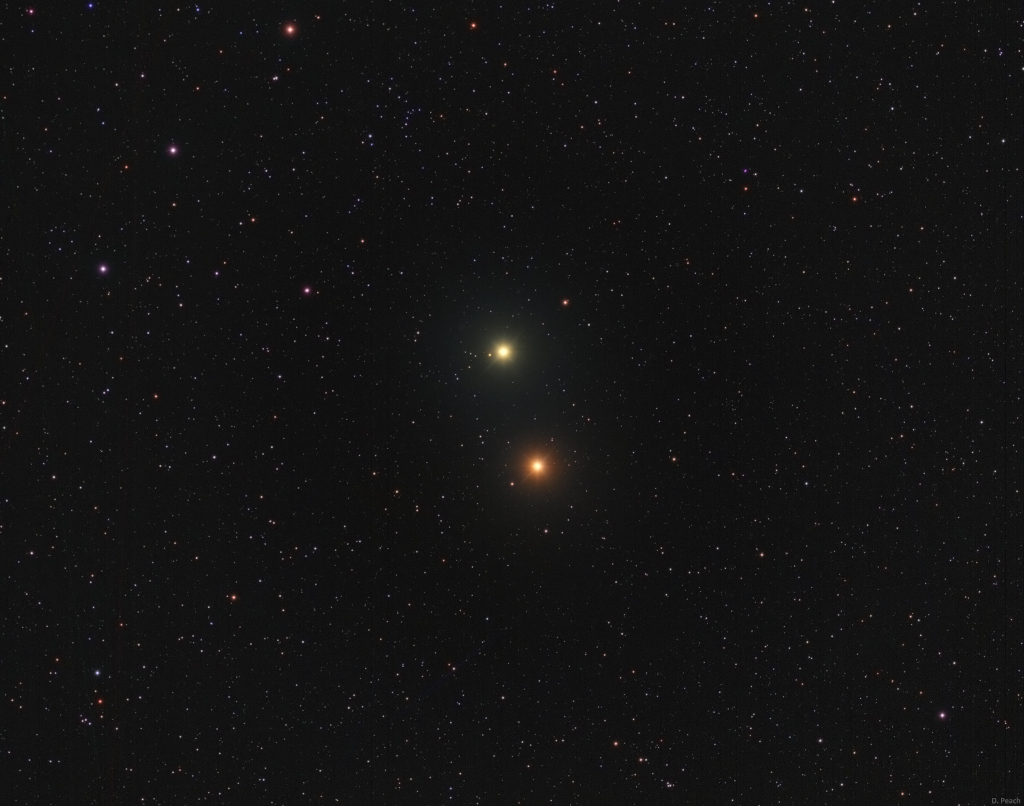09. April 2022
火-土 合相

探索宇宙1!逐工會揀一幅無仝款 ê 影像抑是相片,𤆬你熟似咱這个迷人 ê 宇宙,閣有專業天文學者2為你3解說4。
- 原始文章:Mars-Saturn Conjunction
- 影像來源 kah 版權:Damian Peach
- 台文翻譯:An-Li Tsai (NCU)
[漢羅] 火-土 合相
Tī 這个視野內底,黃道星座摩羯座 ê 方向,有一寡較暗 ê 恆星 tī 黃道面 去予散射去。 中央上光彼兩粒毋是恆星,in 是行星,是火星 kah 土星。 這張 望遠鏡速翕 是 tī 4 月 4 號早起時翕 ê,有翕著透早迷人 ê 合相。 這兩粒行星 ê 距離干焦 1/3 度爾爾。這一看就知影比一粒月娘 ê 視闊度閣較細。 毋知你敢會當 kā 咱講,佗一粒是佗一粒? 你若是臆講火星是較紅彼粒,按呢就予你臆著矣! 火星面頂較暗彼粒土星,反射太陽光,發出黃白色 ê 光。 就算土星較暗,咱嘛是看會著伊上大粒上光 ê 衛星,土衛六 Titan,就 tī 伊 ê 倒爿綴牢牢。
[POJ] Hóe-Thó͘ Ha̍p-siòng
Tī chit-ê sī-iá lāi-té, n̂g-tō seng-chō Mô͘-kiat-chō ê hong-hiòng, ū chi̍t-kóa khah-àm ê hêng-chhiⁿ tī n̂g-tō-bīn khì hō͘ sàn-siā khì. Tiong-ng siōng kng hit nn̄g-lia̍p m̄-sī hêng-chhiⁿ, in sī kiâⁿ-chhiⁿ, sī Hóe-chhiⁿ kah Thó͘-chhiⁿ. Chit-tiuⁿ bōng-oán-kiàⁿ sok-hip sī tī 4 goe̍h 4 hō chá-khí-sî hip ê, ū hip-tio̍h thàu-chá bê-lâng ê ha̍p-siòng. Chit nn̄g-lia̍p kiâⁿ-chhiⁿ ê kū-lî kan-na 1/3 tō͘ niā-niā. Che chi̍t-khòaⁿ to̍h chai-iáⁿ pí chi̍t-lia̍p goe̍h-niû ê sī-khoah-tō͘ koh-khah sè. M̄-chai lí kám ē-tàng kā lán kóng, toh-chi̍t-lia̍p sī toh-chi̍t-lia̍p. Lí nā-sī ioh kóng Hóe-chhiⁿ sī khah âng hip-lia̍p, án-ne to̍h hō͘ lí ioh-tio̍h ah! Hóe-chhiⁿ bīn-téng khah àm hit-lia̍p Thó͘-chhiⁿ, hoán-siā Thài-iông-kng, hoat-chhut n̂g-pe̍h-sek ê kng. Tō-sǹg Thó͘-chhiⁿ khah-àm, lán mā-sī khòaⁿ-ē-tio̍h i siōng tōa-lia̍p ê ūi-chhiⁿ, Thó͘-ūi-la̍k Titan, to̍h tī i ê tò-pêng tòe-tiâu-tiâu.
[KIP] Hué-Thóo Ha̍p-siòng
Tī tsit-ê sī-iá lāi-té, n̂g-tō sing-tsō Môo-kiat-tsō ê hong-hiòng, ū tsi̍t-kuá khah-àm ê hîng-tshinn tī n̂g-tō-bīn khì hōo sàn-siā khì. Tiong-ng siōng kng hit nn̄g-lia̍p m̄-sī hîng-tshinn, in sī kiânn-tshinn, sī Hué-tshinn kah Thóo-tshinn. Tsit-tiunn bōng-uán-kiànn sok-hip sī tī 4 gue̍h 4 hō tsá-khí-sî hip ê, ū hip-tio̍h thàu-tsá bê-lâng ê ha̍p-siòng. Tsit nn̄g-lia̍p kiânn-tshinn ê kū-lî kan-na 1/3 tōo niā-niā. Tse tsi̍t-khuànn to̍h tsai-iánn pí tsi̍t-lia̍p gue̍h-niû ê sī-khuah-tōo koh-khah sè. M̄-tsai lí kám ē-tàng kā lán kóng, toh-tsi̍t-lia̍p sī toh-tsi̍t-lia̍p. Lí nā-sī ioh kóng Hué-tshinn sī khah âng hip-lia̍p, án-ne to̍h hōo lí ioh-tio̍h ah! Hué-tshinn bīn-tíng khah àm hit-lia̍p Thóo-tshinn, huán-siā Thài-iông-kng, huat-tshut n̂g-pe̍h-sik ê kng. Tō-sǹg Thóo-tshinn khah-àm, lán mā-sī khuànn-ē-tio̍h i siōng tuā-lia̍p ê uī-tshinn, Thóo-uī-la̍k Titan, to̍h tī i ê tò-pîng tuè-tiâu-tiâu.
[English] Mars-Saturn Conjunction
Fainter stars in the zodiacal constellation Capricornus are scattered near the plane of the ecliptic in this field of view. The two brightest ones at center aren't stars at all though, but the planets Mars and Saturn. Taken on the morning of April 4, the telescopic snapshot captured their tantalizing close conjunction in a predawn sky, the pair of planets separated by only about 1/3 of a degree. That's easily less than the apparent width of a Full Moon. Can you tell which planet is which? If you guessed Mars is the redder one , you'd be right. Above Mars, slightly fainter Saturn still shines with a paler yellowish tinge in reflected sunlight. Even at the low magnification, Saturn's largest and brightest moon Titan can be spotted hugging the planet very closely on the left.
詞彙學習
| 漢羅 | POJ | KIP | 華語 | English |
|---|---|---|---|---|
| 合相 | ha̍p-siòng | ha̍p-siòng | 合相 | conjunction |
| 黃道 | n̂g-tō | n̂g-tō | 黃道 | zodiacal |
| 黃道面 | n̂g-tō-bīn | n̂g-tō-bīn | 黃道面 | the plane of the ecliptic |
| 摩羯座 | Mô͘-kiat-chō | Môo-kiat-tsō | 摩羯座 | Capricornus |
| 散射 | sàn-siā | sàn-siā | 散射 | scatter |
| 視闊度 | sī-khoah-tō͘ | sī-khuah-tōo | 視闊度 | apparent width |
| 4 月 4 號 | sì goe̍h sì hō | sì gue̍h sì hō | 4 月 4 號 | April 4 |